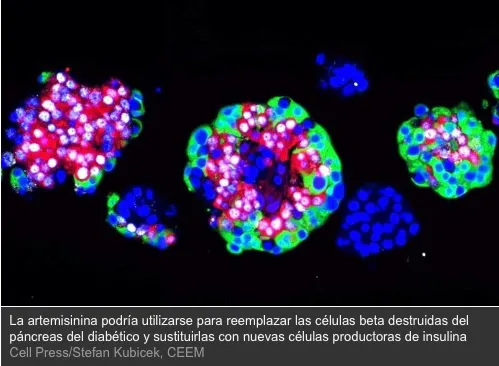A medication commonly used to treat malaria has also proven to be effective in the treatment of diabetes, especially type 1, which usually emerges in childhood and whose origin remains unknown.
Artemisinine could be used to replace the destroyed beta cells of the diabetic pancreas and replace them with new insulin producing cells.
Type 1 diabetes mellitus (DM1) has no cure.In Spain, more than 500,000 people live with this condition, which prevents them from correctly metabolizing sugar.Almost 10 percent of them are children under 15.The figures are increasing: 1,500 new cases are diagnosed every year.
For all of them, the news published yesterday by the CEMM Center (Center for Molecular Medicine) in Vienna is a bombing.And it is that a drug commonly used to treat malaria has also proven to be effective in the treatment of diabetes.Especially of type 1 diabetes, which usually emerges in childhood and whose origin remains unknown.
The medication in question is artemisinin and it seems that it could be used to replace the destroyed beta cells of the diabetic pancreas and replace them with new insulin producing cells.
Type 1 diabetes consists of the partial or total loss of pancreatic beta cells that secrete insulin.In a normal pancreas, these cell acts according to the needs of the organism producing the insulin necessary to metabolize sugars.Every time we eat a source of carbohydrates, they become sugar.Insulin is the key that allows this sugar (vital for body functioning) to become a nutritious metabolite.Without insulin, sugar is not metabolized and accumulates in the blood.
To avoid serious damage that excess blood sugar can generate, type 1 diabetic patients need an artificial insulin supply injected or applied by infusion devices throughout life.There is no known way to recover the function of lost beta cells.
A team of Austrian CEMM researchers, led by Stefan Kubicek, has been looking for years in the vast catalog of available drugs, some that could favor the increase in insulin producing cells.Yesterday they announced that artemisinine can be one of them.How does it work?Beta cells of the pancreas (insulin producers) are one of the cellular typologies that grow within the so -called Langerhans islets that exist in that organ.Other sister cells are alpha, which have the opposite function: if the former produce insulin to reduce blood sugar, the latter increase it producing a substance called glucagon.But both cell typologies are flexible.It is known that alpha cells, sometimes extreme beta cell deficit, also become insulin producers.There is an epigenetic factor called Arx that is responsible for regulating the conversion of a cell in its opposite, a kind of boss who decides what mission he entails each one.
The process seems to be like this: when Arx works, each cell does its job.When blocked, alpha begin to change jobs and also manufacture insulin.
After isolating different cell lines of both types in laboratory, Vienna scientists applied all their drug catalog to discover that artemisimine seems to cause the same effect as when the ARX factor is blocked.Apparently, the medicine sticks to a protein called Gefrina, which activates some cell control centers.As a consequence of a waterfall of chemical reactions that ends up causing alpha cells to secrete insulin instead of glucagon.The discoverers have tried the medicine in zebra fish, mice and rats and have found that they increase insulin production and improve blood sugar levels.At the moment it is not possible to venture what happened to human beings and how long this effect lasts.But researchers believe having opened an unexpected door to a new healing strategy of diabetes.









